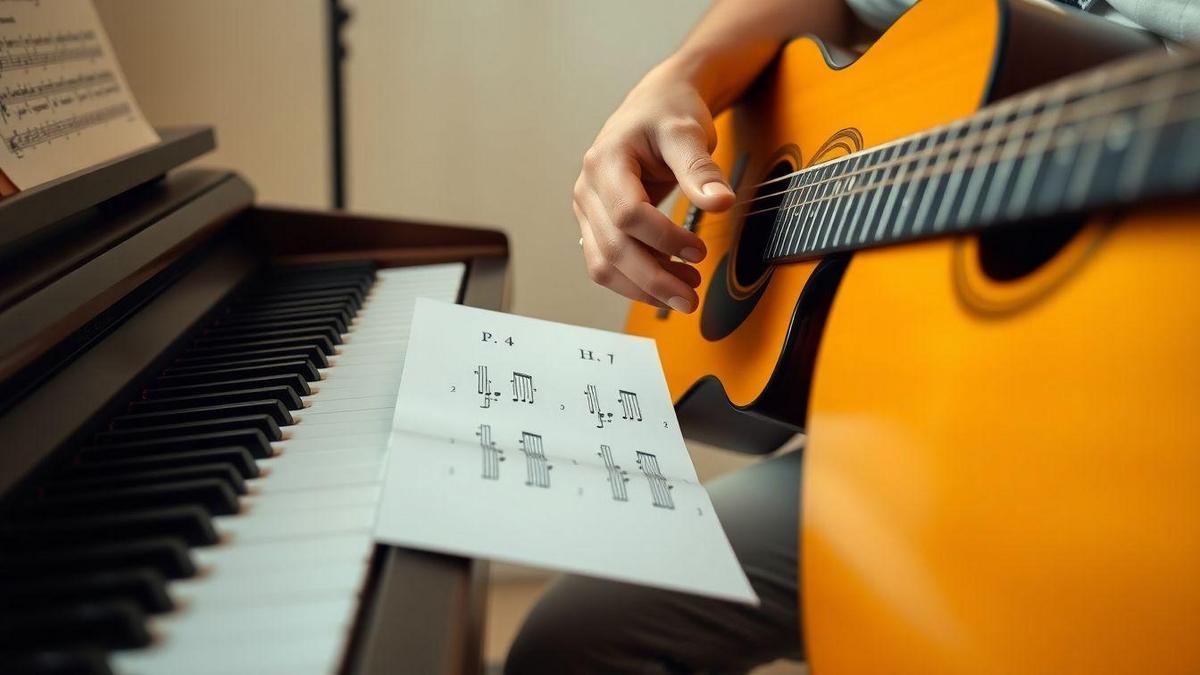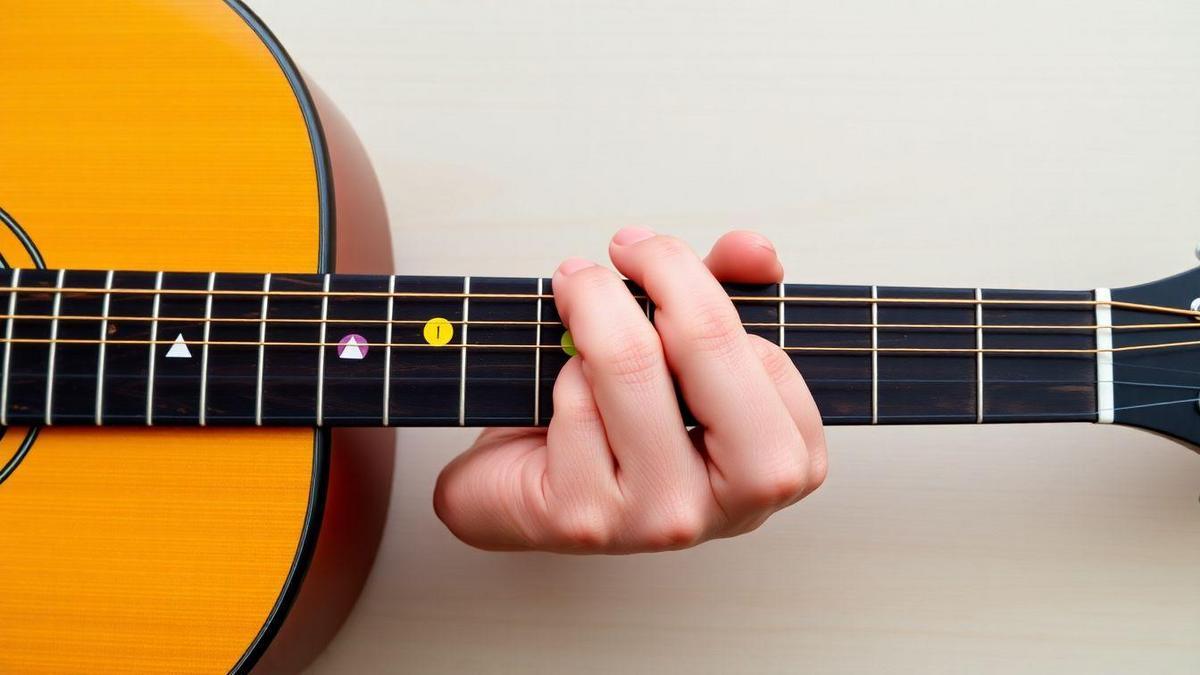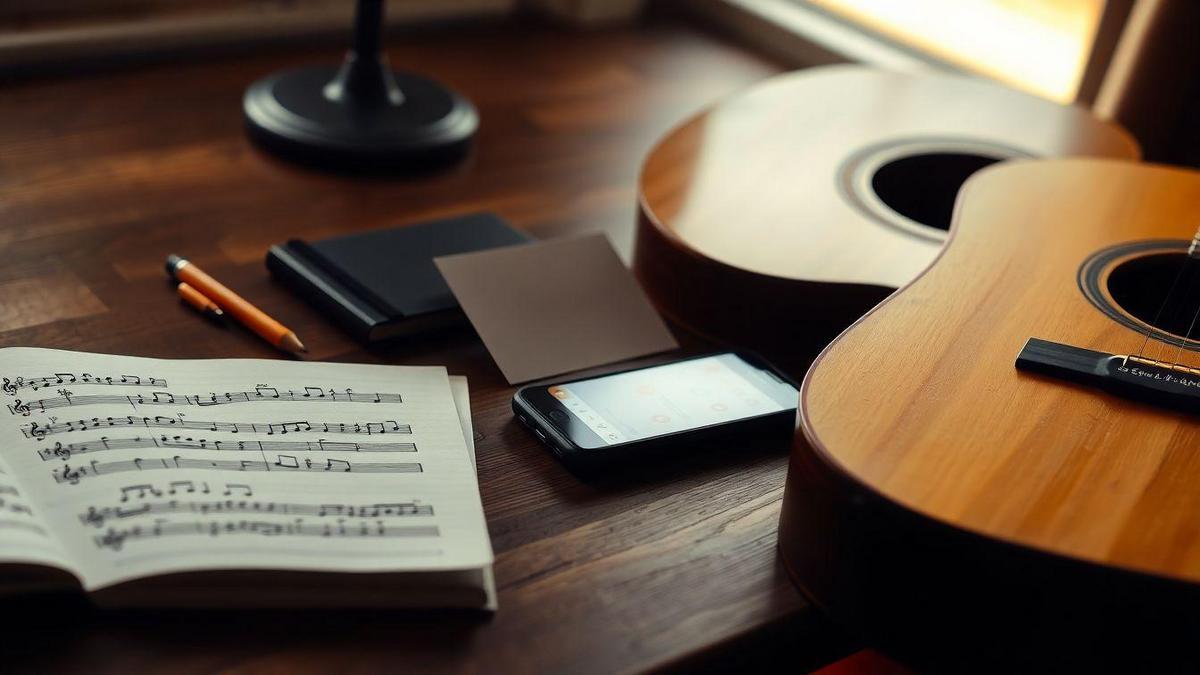Musical intervals made simple with real examples

“Musical intervals made simple with real examples” is the method I use to teach what an interval is and why it matters for playing and songwriting. I show the sound first, name it second, then drop it into a tiny song idea. You get hearing, naming, and using — fast.
Key takeaway — quick sounds to remember
- Sing C → E to hear a bright major third.
- Sing C → E♭ to hear a sad minor third.
- Play C → G to feel a strong perfect fifth.
- Sing low C → high C to hear an octave.
- Sing C → D to hear a close, tense whole step.
What is an interval in one line
An interval is the distance in pitch between two notes.
Why intervals matter for playing and songwriting
Intervals are the building blocks of melody and harmony; see an overview of musical intervals and terminology. Learn them and you can shape mood, voice-leading, and hooks on purpose.
Practical uses:
- Melody tools: choose a minor 3rd for a sad turn or a major 3rd for a bright lift.
- Harmony tools: stack intervals to build chords and textures — see how chords are formed from intervals.
- Ear training: recognize intervals to copy riffs fast.
- Arrangement: move parts by intervals to create space.
How I practice intervals (simple steps):
- Pick a root note.
- Play root, then target interval.
- Name it out loud (major 3rd, perfect 5th).
- Sing it up and down.
- Put it in a 4-bar motif and repeat in different keys — practice intervals across keys and scales helps this stick (scales explained in plain English).
Quick uses right away:
- Add a perfect 5th above a bass line for power.
- Drop a minor 3rd into a chorus for a sad turn.
- Use a tritone for tension that begs resolution.
Basic interval chart (handy reference)
| Interval | Semitones | Simple reference |
|---|---|---|
| Minor 2nd | 1 | “Jaws” motif (ominous) |
| Major 2nd | 2 | first step of “Happy Birthday” |
| Minor 3rd | 3 | small, sad step (blues feel) |
| Major 3rd | 4 | bright, common in pop hooks |
| Perfect 4th | 5 | opening leap of “Here Comes the Bride” |
| Tritone | 6 | dissonant, “Maria” (West Side Story) |
| Perfect 5th | 7 | open and strong — rock riffs |
| Major 6th | 9 | wide, sweet leap |
| Minor 7th | 10 | soulful, bluesy feel |
| Octave | 12 | same note doubled, higher |
For a compact lesson with diagrams and audio, try Interactive lesson on musical intervals.

How I teach major vs. minor (musical, not math)
I use tiny, familiar song snippets and have students hum the two notes, name the interval, then say whether it sounds bright or sad. This is the heart of “Musical intervals made simple with real examples.”
Practice routine:
- Pick one clear example for each interval type.
- Hum the pair, name it, then play it in a new key so you learn the sound, not the song.
Reference examples:
- Major 2nd: “Happy Birthday” (the first small jump).
- Minor 2nd: “Jaws” (tiny spooky step).
- Major 3rd: many pop hooks (bright).
- Minor 3rd: blues/folk drops (sad).
- Perfect 4th: “Here Comes the Bride.”
- Perfect 5th: “Twinkle Twinkle Little Star.”
- Major 6th: “My Bonnie Lies Over the Ocean.”
- Minor 6th: “The Godfather” theme.
Practice tip: pick 4 pairs (M2, m2, M3, m3). Hum the snippet, name it, play it on your instrument, then transpose. Use small expressive techniques to reinforce feeling — see ideas on adding emotion to every note so the same interval carries feeling.
Perfect, diminished, and augmented — a simple rule
I keep it musical: show the sound, spell the letters, then count half steps.
How I decide interval quality:
- Count letter names to get the interval number (C→E = 3rd).
- Is the number in the Perfect family (1, 4, 5, 8) or the Imperfect family (2, 3, 6, 7)?
- Know the base half-step counts (below).
- Count actual half steps on your instrument and compare.
Base half-step chart
| Interval | Base quality | Half steps (base) |
|---|---|---|
| Unison (1) | Perfect | 0 |
| 2nd | Major | 2 |
| 3rd | Major | 4 |
| 4th | Perfect | 5 |
| 5th | Perfect | 7 |
| 6th | Major | 9 |
| 7th | Major | 11 |
| Octave (8) | Perfect | 12 |
Rules:
- Imperfect: Major → one half step smaller = Minor; Minor → one half step smaller = Diminished; Major → one half step larger = Augmented.
- Perfect family: base is Perfect; one half step smaller = Diminished; one half step larger = Augmented.
Clear examples I use:
- C → G = Perfect 5 (7 semitones).
- C → E = Major 3 (4 semitones); C → E♭ = Minor 3 (3 semitones).
- C → G♭ = Diminished 5 (6 semitones); C → G♯ = Augmented 5 (8 semitones).
Visual rule: letters first, half-steps second. Trust spelling for the name even if the pitch looks like another note — if you want a refresher on reading note and chord spelling, check reading chords and sheet music. For a deeper technical treatment, see Rules for interval quality and spelling.

How I train my ear (order and exercises)
I train ear and hands with short, repeatable drills. Sessions are 10–15 minutes and mix singing, playing, and listening.
Listening order I use (so similar intervals don’t confuse me):
- Octave (same note different pitch)
- Perfect 5th (big, open)
- Perfect 4th (clear, steady)
- Major 3rd (bright)
- Minor 3rd (darker)
- Major 6th (wide, sweet)
- Minor 6th (more tense)
- Major 2nd (small step)
- Minor 7th (expressive)
- Tritone (sharp, unstable — last)
Recognition exercises:
- Pair each interval with a song snippet and hum it, then sing the song phrase.
- Transcribe short phrases from songs and label the intervals.
- Call-and-response with an app or partner: they play, you name and sing it, then play it — making practice social and enjoyable helps retention (making practice fun instead of a chore). For hands-on drills, try these Interactive ear training exercises for intervals.
Interval → song quick table
| Interval | Song example | How I practice it |
|---|---|---|
| Octave | “Somewhere Over the Rainbow” (low → high “some…where”) | Sing low then high; match on piano/guitar |
| Perfect 5th | “Twinkle Twinkle” (start) | Hum jump, play rootfifth |
| Perfect 4th | “Here Comes the Bride” | Sing ascending fourth, reverse |
| Major 3rd | “My Girl” / cheerful lifts | Sing, play triad |
| Minor 3rd | “Greensleeves” | Feel the sadness, play slowly |
| Major 6th | “My Bonnie” | Sing and check by playing |
| Minor 6th | “The Godfather” | Isolate and repeat |
| Major 2nd | “Happy Birthday” | Spot small steps |
| Minor 7th | “Somewhere” (WSS) | Use dramatic lines |
| Tritone | “The Simpsons” theme | Treat as spicy interval |
Tip: learn one reference song per interval and make a one-page cheat sheet.

How I practice intervals on piano (step-by-step)
“Musical intervals made simple with real examples” guides this routine: hear it, say it, play it.
Warm-up:
- Pick a root (C or A). Play root, then target (C → E for M3; C → G for P5).
- Sing the target note after the root. Repeat ascending/descending and in different octaves.
- Use a slow metronome (60 BPM), one pair per beat, then speed up.
Fingerings and approach:
- Practice harmonically (together) and melodically (one after another).
- Say the name as you play: “minor 3rd”, “perfect 5th”.
- For wide intervals, split between hands if needed.
Common fingerings (root C)
| Interval | Example (root C) | Right-hand fingering | Left-hand fingering |
|---|---|---|---|
| Minor 2nd | C–D♭ | 1–2 | 5–4 |
| Major 2nd | C–D | 1–2 | 5–4 |
| Minor 3rd | C–E♭ | 1–3 | 5–3 |
| Major 3rd | C–E | 1–3 | 5–3 |
| Perfect 4th | C–F | 1–4 | 5–2 |
| Perfect 5th | C–G | 1–5 | 5–1 |
| Major 6th | C–A | 1–5 | 5–2 |
| Minor 7th | C–B♭ | 1–4/5 | 5–3/2 |
| Octave | C–C’ | 1–5 | 5–1 |
Practice structure:
- Hands separate (2–3 minutes each).
- Make it rhythmic: root on beat 1, target on beat 3.
- Hands together at 60 BPM, four pairs per measure.
- Increase tempo gradually only when clean.
- Randomize roots to build real-world skill.
If you want a simple daily plan to slot this into, follow a compact template for consistency: how to create a simple practice routine daily.

How I teach guitar shapes for intervals
I show small, movable finger shapes and make you hear first, find second.
Octave shapes:
- Same string: 12 frets up.
- Movable shape: two strings toward thinner strings and two frets up (e.g., low E 3rd fret G → D string 5th fret G).
Perfect 5th / power chord:
- Index on root (lower string), ring or pinky on next higher string two frets up (E3 A5 = G power chord). Slides make the shape melodic. Use open strings to hear fifths clearly.
Open-string drill:
- Strum open string, then add the adjacent string two frets up. Move that finger up the neck across string pairs to train the color of the fifth.
Melodic use:
- Slide octave shapes, jump between power shapes, hum the target note before moving. Make intervals melodic, not isolated sounds.

Using intervals to write melodies and set mood
When I write, I pick one interval, play it, and ask: does this feel bright, sad, tense, or open? Then I build a short motif.
Quick mood tags
| Interval | Semitones | Mood |
|---|---|---|
| Minor 2nd | 1 | tense |
| Major 3rd | 4 | bright |
| Perfect 5th | 7 | open |
| Octave | 12 | soaring |
Steps to make sad or happy lines:
- Pick mood word (sad or happy).
- Try appropriate intervals (happy: M3, M6, stepwise; sad: m3, m6, half-step drops).
- Build a 3–5 note motif and repeat with small changes.
- Use rhythm and dynamics to sell the feeling — pairing intervals with expressive phrasing helps when you learn to add emotion to every note.
Tiny hooks from songs (interval-focused):
- “Jaws” — minor 2nd (dread).
- “Somewhere Over the Rainbow” — octave leap (lift).
- “Twinkle Twinkle” — perfect 5th (space, safety).
- “My Girl” — major 3rd (warmth).
Small steps are conversational; big leaps are exclamation points. Anchor leaps with a preceding step if listeners need a guide.

How I build interval training routines
My approach: short focused chunks that make you hear, name, and use intervals. This is “Musical intervals made simple with real examples” in a practice plan.
Principles:
- Stay on a root for a set so your ear has an anchor.
- Practice ascending and descending intervals.
- Mix singing and playing.
- Repeat intervals in different keys to train recognition.
- Attach song cues to each interval for instant recall.
Use short focused practice blocks to stay consistent — the power of short daily sessions scales well with interval drills.
Compact interval cheat sheet (song cues)
| Interval | Sound cue / song |
|---|---|
| m2 | “Jaws” (tension) |
| M2 | “Happy Birthday” |
| m3 | “Greensleeves” (sad) |
| M3 | “My Girl” (bright) |
| P4 | “Here Comes the Bride” |
| TT | “The Simpsons” / movie tension |
| P5 | “Twinkle Twinkle” |
| m6 | “The Entertainer” (opening) |
| M6 | “Somewhere Over the Rainbow” |
| m7 | bluesy lead-ins |
| P8 | octave double |
My 10‑minute daily drill (model)
- Warm-up (1 min): hum a root and slide an octave.
- Isolation (3 min): pick one interval (e.g., minor 3rd). Play/sing root → interval → root, 8 reps.
- Call & response (3 min): app or partner plays, you guess and sing it back, then play it.
- Song cue recall (2 min): sing a song that uses the interval and label it.
- Log (1 min): jot one line about hits/misses.
If you miss an interval, repeat it three times in different keys immediately. Alternate sung and played practice. Struggling to start? Practical tips to beat practice procrastination can help you make this model stick.
Apps and tools I use:
- Functional Ear Trainer (relative pitch).
- Tenuto (interval drills).
- EarMaster (rhythm interval exercises).
- Interval Trainer apps for quick reps.
- Any keyboard app to hold a stable root.
- Metronome to keep sessions disciplined.
Track progress with a simple log: date, drill type, interval focus, success rate (e.g., 8/10), quick notes. If an interval is under 70% for the week, make it tomorrow’s focus.

Mapping intervals to familiar songs (fast memory hacks)
I teach intervals by pointing to songs you already know. This reinforces “Musical intervals made simple with real examples.”
Five pop lines I use:
- “Happy Birthday” — octave landmarks.
- “Somewhere Over the Rainbow” — major 6th leap.
- “The Star-Spangled Banner” — perfect 5th jump.
- “My Girl” — major 3rd lift.
- “Jaws” — minor 2nd crawl.
Match each song clip to your cheat sheet and practice until the song pops into your head when you hear the interval — this leverages how songs connect to personal memories for fast recall.
Conclusion
Intervals are the musical building blocks that decide mood, motion, and melody. Learn to sing, play, and name them with short routines, song anchors, and a cheat sheet, and intervals stop being theory and start being tools you use every day.
Start with a clear routine: pick a root, sing the target, play it, count half steps to check quality, and pin a cheat sheet where you practice. Use “Musical intervals made simple with real examples” — hum first, play next, then write. Do a little every day and your ear, your playing, and your songwriting will improve fast.
If you want more hands-on lessons like this, explore approachable theory and songwriting tips such as approachable music theory for songwriters or visit the site homepage at https://clickneutro.com.
